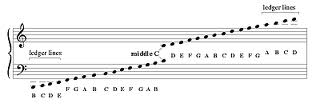Reading ledger line notes seems like an overwhelming task. Whose idea was it to attach tiny little lines with notes to the music staff anyways?
I’m not sure I can answer that question, but I do know that we need more notes to create music than what can be held on the staff alone.
The five lines and four spaces of the music staff simply can’t hold them all.
This problem is solved by adding ledger lines. Notes are placed on the ledger lines creating ledger line notes. They extend both above and below the staff.
| ✅ The best self-study music theory book loved by all my readers and students. |
Which staff are you talking about? Well, you can find ledger line notes in all staves.
However, we are going to mainly focus on the treble clef and bass clef since that is what most people read.
My purpose here is to point out a few things in common between the treble clef and bass clef ledger lines.
Now, get ready for this easy short cut that is about to make your life a little bit easier.

If you look at the note C in the treble and bass clef, you will notice something similar. Two ledger lines above treble clef is C. Two ledger lines below bass clef is also C.
Interesting, huh? Now, all you have to remember is two lines above treble clef is C and two lines below bass clef is C. That is pretty easy.
But, what about the C between the two staves. This is middle C.
You can read middle C in either bass clef or treble clef. It will look the same in each clef. One line below treble clef is C and one line above bass clef is C. Cool!
If you are a piano player and need to read both treble clef and bass clef, this is a pretty handy tool to remember.
Now, you can start at the C’s and work your way forward or backward through the musical alphabet to figure out the other ledger line notes.
Just remember that anytime you move up the staff, you go forward in the musical alphabet.
Whenever you move down the staff, you move backward through the alphabet. This applies to any clef.
Wow, who would have thought there would be a short cut to reading ledger line notes? There certainly is and it is worth remembering.
Now that you know a simpler way to identify treble clef and bass clef ledger line notes, your job is to practice, practice…practice!
Keep at it and you will develop mastery at reading all kinds of music notes.
Recommended Music Theory Books
✅ The best self-study music theory book loved by all my readers and students.

Thanks, your tips for remembering ledger lines was really helpful. I have played in a handbell choir for a couple of years, but now have joined a bass bells group. My ledger line reading is shaky, so I appreciate your help.
Thanks again,
Rosemary Parris
Hi Rosemary,
I am glad this has helped you. I think ledger line reading is hard for everyone. I am constantly looking for short-cuts to make it easier. So glad you are playing handbells! I bet you are having a great time with it.
Please let me know if there is anything else I can help you with. I’m glad to help! 🙂
Holy smokes it really works!Thanx so much for the tip! You are awesome :}
Hi Robbin,
I am glad this tip helped! Let me know if there is anything else I can help you with.
THANKS!!!!!
HI! I am a professional musician and have been for forty years! I’m a composer/arranger/pianist and consider myself an excellent sight reader but I have to admit that after all these years of playing and giving I still have difficulties with ledger lines! Do you know of any printed material or exercises that focus purley on ledger line reading?
Thnx
Hi Nelson! The ledger lines can really be a killer sometimes. Flute players read them every day, so they are forced to learn how to read ledger lines well and at a faster rate than everyone else. I don’t know of any materials or exercises available that may help. There seems to be a lot of things us musicians really need that are just not out there. I am working on a developing more things right now. It looks like I need to create some Speed Reading exercises that use ledger lines in the near future!
In the mean time, pull out as much music as you can with ledger lines (or write a page of ledger line notes on staff paper) and go through it each day pointing to the notes and naming them out loud. Don’t always move in the same pattern. Skip around and randomly point and name notes too. In time, you will see yourself gradually speeding up and comfortably reading them with ease.
You basically have to submerge yourself with ledger lines for awhile in order to get this skill better developed. I hope this helps!
Thnx for your response Teresa. I actually came up with a pretty good way to work on it…I’ve taken some orchestrations I’ve done in Finale and I’ve transposed the bass part down an octave which pretty much gives me lots of ledger lines under the bass clef staff to read. And then I transpose up an octave (or two) and get to practice reading ledger lines above the bass clef staff. Then I just applied the same principle to treble clef parts. Works great and now I’ve got lots to read and practice. : )
Thanks so much for the visual of the staff. It’s the best one I’ve found.
I play the piano at the local nursing home and occassionaly get requests to play a hymn I’ve never heard. I’d look it up in the hymnal but
I play by ear, and everytime I start to “read” a musical piece, I end up playing it by ear the second time.
Is learning to read music a dead end for me?
Thanks for this. Please notice that it’s “WHOSE idea”. 🙂
Thank you!
How useless. I already knew this and I still can’t read ledger line notes fast enough.
If you are looking for a shortcut to practicing, there is none. Practice, practice, practice…